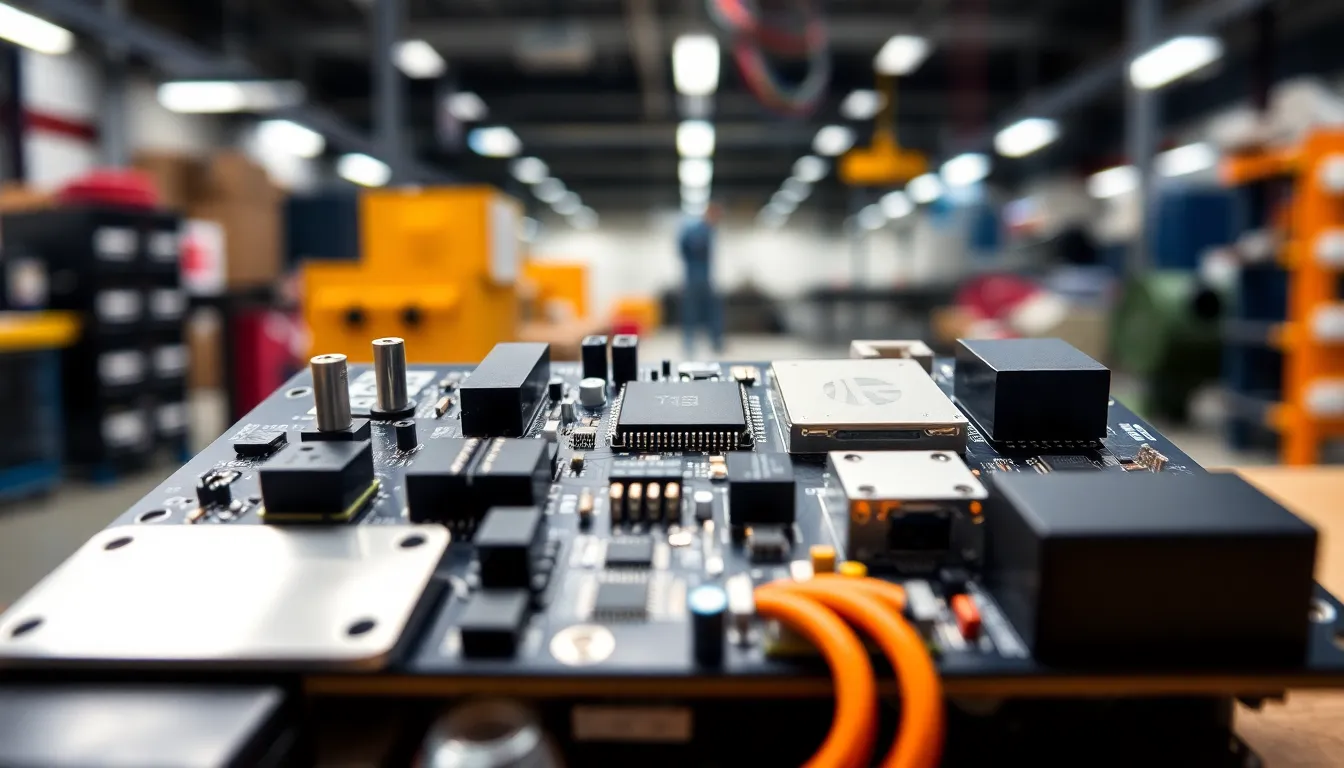In a world where your toaster can chat with your fridge, IoT product development isn’t just a tech trend—it’s a revolution. Imagine a future where everyday objects become smart companions, transforming mundane tasks into seamless experiences. If you think your coffee maker can’t be your new best friend, think again!
Table of Contents
ToggleOverview of IoT Product Development
IoT product development encompasses the design and creation of interconnected devices that communicate over the internet. This process involves multiple stages, from ideation to deployment. Product teams must understand user needs, technical capabilities, and market trends to succeed.
Several key components drive IoT product development. Hardware development focuses on selecting sensors, processors, and communication modules. A robust embedded system is essential for functionality. Software development facilitates interaction between devices, often through cloud platforms. Integration with existing ecosystems also plays a crucial role.
Security remains a top priority in developing IoT products. As devices gather personal data, protecting this information from breaches is vital. Companies employ encryption, secure protocols, and regular updates to mitigate risks.
Testing and validation are critical steps in ensuring product reliability. Teams conduct performance testing to assess how devices operate under various conditions. User feedback during beta testing can also reveal areas for improvement.
Market analysis guides positioning strategies during the development phase. Identifying competitors and target audiences informs feature sets and pricing models. Adapting to user feedback post-launch enables continuous improvement.
Regulatory compliance impacts product design and functionality. Different regions have distinct regulations that govern IoT devices, affecting everything from data handling to device performance. Staying abreast of these regulations guarantees market readiness.
Cross-disciplinary collaboration enhances IoT product development outcomes. Engineers and designers must work closely, ensuring that technical capabilities align with user experiences. This synergy fosters innovative solutions that meet consumer demands effectively.
Innovation drives the evolution of IoT products. Emerging technologies like artificial intelligence and machine learning create smarter, more responsive devices. Staying ahead of technological advancements ensures competitive advantage in the ever-evolving IoT landscape.
Key Components of IoT Product Development

IoT product development encompasses various essential components that contribute to its success. Understanding these components ensures effective design and functionality.
Hardware Considerations
Choosing the right hardware is fundamental in IoT product development. Sensors collect data from the environment, while processors analyze this data. Manufacturers often prioritize energy efficiency and size in their hardware selections. Battery life can significantly impact user experience, requiring careful design choices. Components like microcontrollers and communication modules facilitate device interaction. Evaluating the durability of materials also plays a critical role, especially for devices intended for outdoor use.
Software Development
Software development acts as the backbone of IoT functionality. Operating systems manage hardware resources efficiently, while applications provide user interfaces for interaction. Developers often build software on cloud platforms to enable real-time data processing and storage. Implementing robust security protocols protects user data from unauthorized access. User experience design is equally important, influencing how easily individuals can engage with the technology. Integration of artificial intelligence enhances device learning capabilities, making products more adaptive.
Connectivity Solutions
Establishing reliable connectivity is crucial for IoT devices. Various protocols, such as Wi-Fi, Bluetooth, and Zigbee, offer different advantages depending on the application. Each connectivity solution influences the range, power consumption, and data transmission speed. Manufacturers often select methods based on use case requirements and environmental conditions. Security features within these protocols protect data during transmission. Scalability also plays a role, allowing devices to accommodate growing user bases and evolving technology.
Challenges in IoT Product Development
Addressing challenges in IoT product development is crucial for success. Various factors can impact the development process.
Security Concerns
Security concerns rank as a top challenge in IoT product development. End devices often lack robust protection, making them vulnerable to cyber threats. Companies must implement strong encryption methods to safeguard user data. Regular software updates and patch management are essential for addressing vulnerabilities. Data breaches can result in significant reputational damage and financial loss. Establishing a security-first approach throughout the development lifecycle is necessary. Continuous monitoring and threat detection systems can enhance overall security measures. Organizations that prioritize security can better protect consumers and build trust in their products.
Scalability Issues
Scalability issues frequently arise during IoT product development. As the number of connected devices grows, infrastructure may struggle to handle increased data traffic. Companies need to design systems capable of scaling efficiently without compromising performance. Selecting appropriate cloud services can facilitate seamless expansion. Strategies for load balancing and data management must be implemented to ensure reliability. Anticipating future growth will inform design decisions and resource allocation. Early planning for scalability enables developers to create products that adapt to evolving market demands. Addressing these challenges effectively creates a foundation for long-term success in IoT product offerings.
Best Practices for Successful IoT Product Development
Focusing on specific practices enhances the success of IoT product development. Prioritization of user needs and rigorous testing stand out as essential elements.
User-Centric Design
User-centric design signifies understanding the end-user’s needs and preferences. Emphasizing functionality leads to increased satisfaction and adoption. Gathering feedback throughout the development process ensures that products align with user expectations. Iterative design approaches enable continuous improvements based on real-world usage. This adaptability fosters trust and encourages users to engage with smart devices. Employing analytics tools aids in tracking how users interact with products, helping to refine features and functionalities. Prioritizing accessibility ensures all users can benefit from IoT innovations.
Prototyping and Testing
Prototyping and testing form the backbone of successful IoT development. Early-stage prototypes allow teams to visualize concepts and gather critical feedback. The testing phase evaluates both performance and user experience, revealing potential issues before launch. Conducting usability tests with real users identifies pain points and areas for improvement. Furthermore, integrating automated testing can streamline the process and uncover defects. Conducting security assessments during testing protects against vulnerabilities that could compromise user data. Iterating through prototypes based on test results ensures a robust final product. Employing a continuous feedback loop throughout development maintains product relevance and effectiveness.
Future Trends in IoT Product Development
Emerging technologies are reshaping IoT product development. Artificial intelligence (AI) is a major driver, enhancing device intelligence and decision-making capabilities. Machine learning algorithms enable devices to learn from user behavior, creating personalized experiences.
5G network deployment significantly impacts IoT connectivity. This technology allows faster data transmission and reduced latency, making real-time communication possible. The increased bandwidth supports a larger number of connected devices, enhancing scalability.
Edge computing plays a vital role in IoT evolution. Processing data closer to the source reduces the load on cloud services. This approach not only improves response time but also enhances data security by minimizing data transmission over the internet.
Sustainability is becoming a priority in IoT product design. Companies are exploring energy-efficient hardware and eco-friendly materials. Users are increasingly drawn to products that align with their environmental values, influencing market trends.
Interoperability is another crucial factor for future IoT development. Standard protocols will foster seamless communication between devices from different manufacturers. This shift will simplify user experiences while promoting integration in smart homes and cities.
Privacy regulations continue to evolve, impacting product development strategies. Companies must stay compliant with laws like GDPR and CCPA, ensuring user data protection. Transparency in data usage enhances consumer trust and encourages wider adoption.
User experience remains fundamental to successful IoT products. Developers focus on intuitive interfaces that enhance usability and accessibility. Engaging design and functionality will drive higher user satisfaction and retention rates.
Investing in security measures is non-negotiable in the IoT landscape. Organizations are prioritizing encryption and regular software updates to protect personal information. As threats become more sophisticated, robust security protocols will safeguard user trust and product integrity.
The landscape of IoT product development is rapidly evolving. As technology advances, companies must stay ahead by embracing innovative practices and prioritizing user needs. The integration of artificial intelligence and machine learning will continue to enhance device capabilities and personalization.
Security and scalability remain paramount challenges that require proactive strategies. By focusing on robust encryption and efficient infrastructure, businesses can build trust and ensure their products meet growing demands.
Looking forward, sustainability and interoperability will shape the future of IoT products. Companies committed to these principles will not only foster consumer loyalty but also contribute to a more connected and responsible world. The journey of IoT development is just beginning, and the possibilities are limitless.

